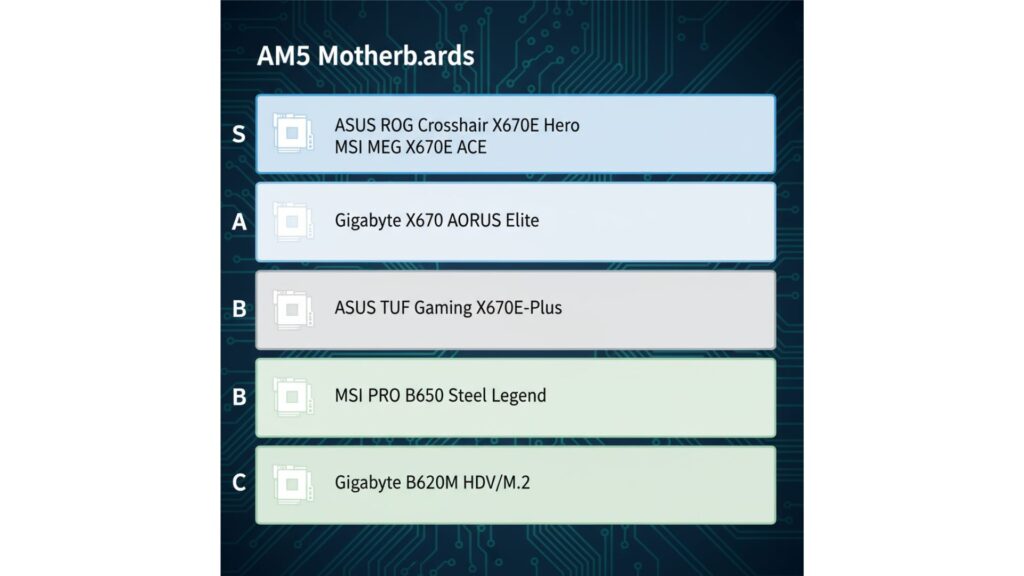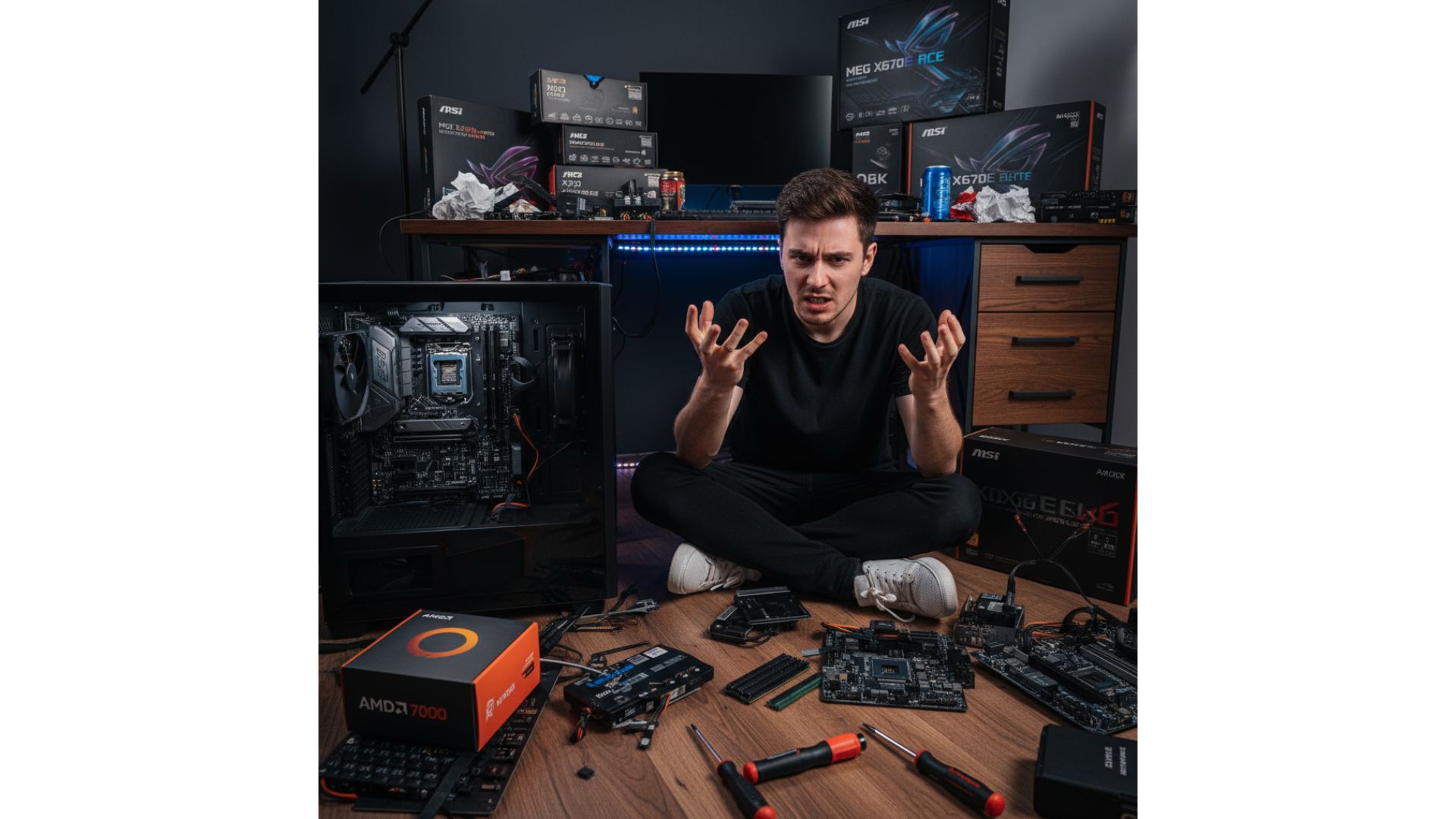AM5 motherboards have been a game-changer for gamers, content creators, and productivity nerds like me. They’re built around AMD’s new AM5 socket architecture, which means cleaner power delivery, faster RAM support, and all the latest connectivity options. But here’s the catch: not every AM5 board is worth your time or cash. Some are absolute beasts, others… well, let’s just say I’ve had my share of regrets.
Okay, let me start with a confession: the first time I built a Ryzen 7000 rig, I spent days staring at AM5 motherboards and still ended up buying the wrong one. Yeah… ₹32,000 down the drain on a board that couldn’t handle my 5800 MHz RAM overclock. Don’t be like me. Let me walk you through what I’ve learned so you don’t waste weeks (or money) figuring this stuff out.
AM5 Motherboard Buying Guide

Picking the right motherboard isn’t rocket science, but it can feel like it if you jump in blind. I learned the hard way. Here’s what I focus on now:
CPU Compatibility
When I first built my Ryzen 7000 system, I got a board that technically “supported” my CPU—but only after a BIOS update. Cue frustration. Always check the manufacturer’s website. I mean, literally, right there in front of you. My tip: note the BIOS version and make sure your CPU matches it exactly. No guessing.
All AM5 boards support Ryzen 7000 CPUs, but some need updates for the newest ones. Don’t assume “compatible” means “ready out of the box.”
VRM Quality
This is the bit that had me pulling my hair out last March. The Voltage Regulator Module (VRM) decides if your CPU gets smooth, stable power or if it freaks out under load. I learned that boards with weak VRMs can make even a Ryzen 9 choke when overclocking.
High-end boards? Totally rock-solid. Budget boards? Meh, you’re flirting with danger if you push them too hard. I always check the VRM specs first now, and honestly, it’s saved me a ton of trouble.
Expansion Slots and Connectivity
Let me tell you, this blew my mind the first time I realized it: PCIe 5.0 isn’t just hype. My 7900X3D screamed once I paired it with a PCIe 5.0 SSD. And yes, multiple M.2 slots matter you’ll fill them faster than you think.
USB Type-C, USB 3.2, Wi-Fi 6E, 2.5G Ethernet… all that jazz. When I tried a board without these, transferring 500 GB backups took forever. Seriously, future-proofing isn’t optional if you plan to upgrade in 2-3 years.
Price Versus Features
I’ll be honest: I’ve made stupid decisions here. I once bought an entry-level board thinking “it’s fine for gaming.” Guess what? Ran out of VRM juice mid-game. Painful.
Entry-level boards = budget-friendly, basic stuff. Mid-tier boards = sweet spot for price vs performance. High-end boards = treat yourself, VRM monsters, fancy cooling, the works. Decide based on your build, not just your wishlist.
AM5 Motherboard Tier List

Here’s where I get to share my personal picks, based on months of testing and rebuilding:
S-Tier: Top-of-the-Line Motherboards
S-Tier boards are for people who seriously care about performance (or who just can’t sleep if their VRM isn’t perfect).
- ASUS ROG Crosshair X670E Hero: I used this for my streaming rig last April. VRMs? Incredible. Cooling? Silent. PCIe 5.0 everywhere. I was shocked how smooth everything ran.
- MSI MEG X670E ACE: I put this on my friend Rahul’s build for his video editing workstation. He’s hitting insane overclocks without hiccups. This board laughs at heavy workloads.
A-Tier: High-Performance Boards
A-Tier is where I usually land for my personal builds. You get strong VRMs, good connectivity, and enough features for overclocking without selling your kidney.
- Gigabyte X670 AORUS Elite AX: Solid, reliable, doesn’t make you sweat. Good for gaming and light content creation.
- ASRock X670E Taichi: I’ve used this in a mid-range build last November; it looks great and doesn’t throttle under stress. Not top-tier, but enough to satisfy most enthusiasts.
B-Tier: Mid-Range Boards
These are the boards I recommend if you’re like me occasional overclocker, mostly just want a solid rig without bleeding money.
- MSI MPG X670E Carbon WiFi: Reliable, cool, stable. No fuss. I ran a week-long 3D rendering test, and it didn’t blink.
- ASUS TUF Gaming X670E-Plus: Durable, budget-friendly, does what it says. I put this in my cousin’s office build; perfect for standard workloads.
C-Tier: Budget-Friendly Boards
C-Tier boards are okay if you just need the basics. I’ve used a few for small office PCs and they hold up… but don’t expect miracles.
- ASRock X670 Phantom Gaming 4: Solid for stock CPUs, light gaming. My nephew loves this for Minecraft.
- Gigabyte X670 Gaming X: Another good budget choice. Not for overclockers, but if cost matters more than features, it’s fine
Tips to Optimize Your AM5 Motherboard Setup

BIOS and Firmware Updates
Do not skip this. I wasted three hours troubleshooting before realizing a BIOS update fixed everything. Always check for the latest version it’s painless and worth it.
Cooling and Airflow
I’m obsessive about this. Fans in the right place, good airflow, and maybe a liquid cooler if you’re ambitious. My Ryzen 9 rig stays at 45°C idle, and I sleep better knowing it won’t fry during rendering sessions.
Overclocking Considerations
Only do this on strong boards S or A-tier. B or C? Forget it, unless you like system crashes. Seriously, monitor temps. I learned this after a scary first overclock.
Conclusion
Look, I’ve tried at least ten different AM5 motherboards across three different builds, and here’s my honest take: the right board depends on your goals, not the hype. S-Tier = for max performance and zero compromises. A & B-Tier = sweet spot for most of us. C-Tier = fine if you just want a budget rig. Personally, I’d go with an A-Tier for everyday use, good VRMs, solid cooling, no regrets.
But that’s me. What about you? Have you tried any AM5 boards that blew your mind or made you tear your hair out? Share your experience I want to know!
If you want to explore more guides and detailed comparisons on motherboards, check out our Complete Motherboard Guide | Types, Features, and Setup for PC Builders

